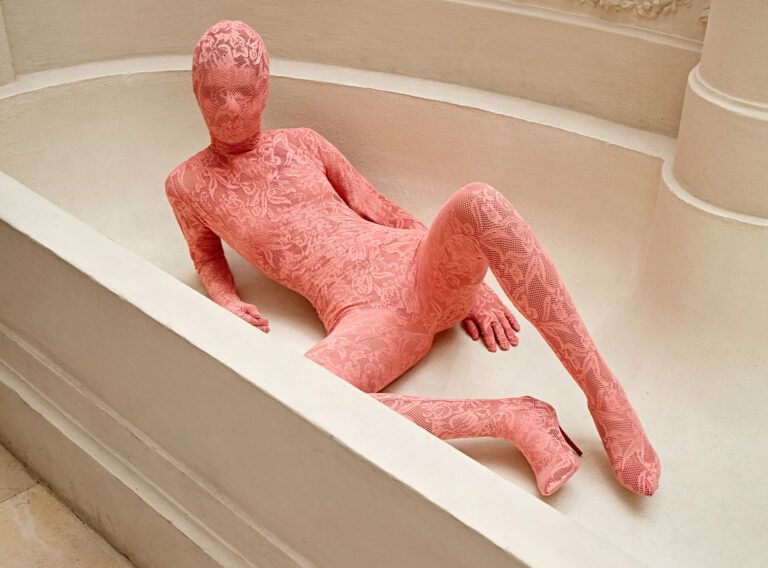Your artworks portray a sense of euphoria, intoxication, and jubilation, contrasted with underlying insecurities. How do you convey this duality?
For many, intoxication is first of all desirable. The feeling of being alive. Longing, escape from everyday life, excess, dopamine, wealth, power, consumption and the feeling of dolce vita. Such moments can be deceptive. All this is not eternal. The higher we climb, the deeper we fall. My hedonistic characters are usually in euphoric situations, actions or states. At first glance, everything seems easy. However, the exaggerated facial expressions and gestures ironically trigger insecurity and vulnerability, leaving the viewer with a certain skepticism. The images are intended to embody an interplay between tension and relaxation, desire and vulnerability, between reason and loss of control, eternity and transience. But all that also with a wink.


Bright and garish colours are some of the main visual elements in your artworks. Can you explain how these colours contribute to the overall effect and atmosphere of the pieces?
The positive, bright colours emphasize the euphoria, the feeling of lightness, the flashy wildness and, at first glance, the naive childishness. They emphasize pleasure and enthusiasm.
The viewers are able to reflect on their own life situations in the scenes depicted in the artworks. How do you create a sense of relatability or personal connection for the viewers? And are there specific messages or emotions that you aim to evoke?
Reality is often difficult and constricting. In contrast, I want to give the viewer a simple, quick and humorous approach through familiar everyday situations or positively wishful thinking. The recognition of one’s own conditions and longings also makes it easier to empathize with the characters. It is important to me that they bring a kind of depersonalization. Through neutrality in gender and skin colour, through banal everyday situations, everyone can feel addressed. Through a longer glance, however, insecurities and the questioning of privileges arise. Is it really as pleasurable and positive as it seems or just a disguise of human abysses? But, of course, what must never be missing is the humour and lightness.



Can you discuss your creative process and techniques? How do you approach the use of colour and composition?
The idea first arises exclusively in my head. I can’t describe the process exactly but you collect all the impressions and experiences and subconsciously form themes that flow into the pictures. Sometimes, I can only recognise this half a year later, for example. So, I try again and again to visualize a picture to finally bring a rough sketch as a reminder on paper. Then I go to the pre-painting on canvas. I try to give the rough idea a harmonious structure. It should simply feel balanced. The space-filling focus is usually on one or the interaction of several figures. A suggestion of a scenery or a place or space with graphic elements or details are also important to me.
The rest arises during the painting process. I never specify colours beforehand. When I was starting, the images were more pre-planned and always ended up looking very different. In the meantime, a lot happens intuitively in the process. That’s why I don’t want to limit myself in the beginning with an idea planned down to the last detail. Through the superimposed layers of colour, I approach the sought-after colour harmony.


How does your work challenge or subvert traditional artistic conventions? Are there any unique or innovative approaches that you take in your pieces?
Having not studied painting, I am relatively unbiased and have a free approach to my work. My yellow figures form a distinctive feature and are easily recognisable. At the moment, I experiment with various colours, techniques, and materials applied in several layers of paint to give the image a deeper texture. This means I currently mix acrylic, oil, oil sticks and work with brushes and with the occassional airbrush. I myself am super excited about what can result from the process.
In what ways do you engage with contemporary society or current cultural trends?
Politics is generally a big and important thing to me.The topics that concern me most are social inequalities, distribution of wealth and the social relationship of power in our time. Privileges that we have or do not have. Human abysses behind the positive facades and desires. Intoxication as a symbolic image of unlimited wealth.
In my opinion, one can never completely free oneself from trends or current topics. However, it is often the trendy content that moves our society forward. For example, the question of identity. Through a neutrality in skin colour and external features in my figures, I would like to take up this theme consciously but still leave it open for interpretation for everyone.



Looking forward, what can we expect from you in terms of future projects or artistic endeavours? Are there any new themes or directions you are exploring in your work?
At the moment, I’m working on my next solo exhibition, collecting ideas, elaborate the concept and simply try to achieve “flow“. I did not want to anticipate so much in this regard but it will probably move thematically to a luxurious villa with all its weird scenarios, hidden desires, spaces and power relations. Until then, I want to develop, try a lot of things, and just leave it open for now to see what comes out of it.




